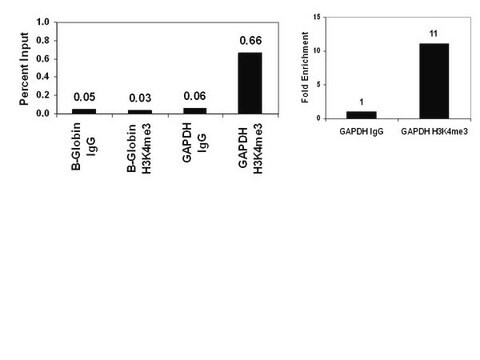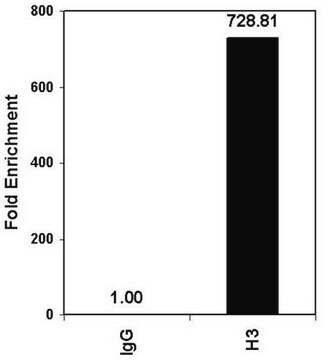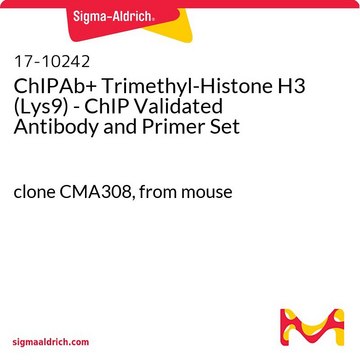17-625
ChIPAb+ Trimethyl-Histone H3 (Lys9) - ChIP Validated Antibody and Primer Set
from rabbit
Sinónimos:
H3K9me3, Histone H3 (tri methyl K9), Histone H3K9me3
Iniciar sesiónpara Ver la Fijación de precios por contrato y de la organización
About This Item
UNSPSC Code:
12352203
eCl@ss:
32160702
NACRES:
NA.41
Productos recomendados
biological source
rabbit
Quality Level
clone
polyclonal
species reactivity
human, mouse, vertebrates
manufacturer/tradename
ChIPAb+
Upstate®
technique(s)
ChIP: suitable
dot blot: suitable
western blot: suitable
NCBI accession no.
UniProt accession no.
shipped in
dry ice
Gene Information
human ... H3F3B(3021)
Categorías relacionadas
General description
All ChIPAb+ antibodies are individually validated for chromatin precipitation, every lot, every time. Each ChIPAb+ antibody set includes control primers (tested every lot by qPCR) to biologically validate your IP results in a locus-specific context. The qPCR protocol and primer sequences are provided, allowing researchers to validate ChIP protocols when using our antibody in their chromatin context. Each set also includes a negative control antibody to ensure specificity of the ChIP reaction.
The ChIPAb+ Trimethyl-Histone H3 (Lys9) set includes the Anti-trimethyl-Histone H3 (Lys9) antibody, a negative control antibody (purified rabbit IgG), and qPCR primers which amplify a 117 bp region within the 3’ end of the human ZNF554 gene. The trimethyl-histone H3 (Lys9) and negative control antibodies are supplied in a scalable "per ChIP" reaction size and can be used to functionally validate the precipitation of trimethyl-histone H3 (Lys9) associated chromatin.
The ChIPAb+ Trimethyl-Histone H3 (Lys9) set includes the Anti-trimethyl-Histone H3 (Lys9) antibody, a negative control antibody (purified rabbit IgG), and qPCR primers which amplify a 117 bp region within the 3’ end of the human ZNF554 gene. The trimethyl-histone H3 (Lys9) and negative control antibodies are supplied in a scalable "per ChIP" reaction size and can be used to functionally validate the precipitation of trimethyl-histone H3 (Lys9) associated chromatin.
The methylation of histones can occur on two different residues: arginine or lysine. Histone methylation can be associated with transcriptional activation or repression, depending on the methylated residue. Lysine 9 of histone H3 can be mono-, di- or trimethylated by different histone methyltransferases (HMTs) such as SuvH39H1 or G9a. This methylated lysine can be demethylated by histone demethylases as JMJD1A, LSD1 or JMJD2C. Methylation of this residue is mainly associated with transcriptional repression.
Specificity
Recognizes histone H3, Mr 17 kDa, trimethylated at lysine 9.
The immunogen sequence is identical in a wide range of animal and plant species, so broad cross-reactivity is expected.
Immunogen
The trimethyl-histone H3 (Lys9) purified antibody is made against BSA-conjugated, synthetic peptide containing the sequence …AR[me3K]S… in which me3K corresponds to trimethyl lysine 9 of human Histone H3.
Application
Chromatin Immunoprecipitation:
Sonicated chromatin prepared from 2x106 HeLa cells were subjected to chromatin immunoprecipitation using 4 μg purified antibody or normal rabbit IgG and the Magna ChIP A kit (Cat. # 17-610).
Successful enrichment of trimethyl-Histone H3 (Lys9) associated DNA fragments was verified by qPCR using ChIP Primers GAPDH flanking the human GAPDH promoter and primers targeting the promoter of human MyoD.
Please refer to the EZ-Magna ChIP A (Cat. # 17-408) or EZ-ChIP (Cat. # 17-371) kit protocols for experimental details.
Western Blot Analysis:
Recombinant Histone H3 (Lane 1) and HeLa acid extract (Lane 2) were resolved by electrophoresis, transferred to nitrocellulose and probed with anti-trimethyl-Histone H3 (Lys9), (1 μg/mL). Proteins were visualized using a goat anti-rabbit secondary antibody conjugated to HRP and a chemiluminescence detection system (Please see figures).
Beadlyte Histone Peptide Specificity Assay:
0.5 μg/ml of purified anti-dimethyl-Histone H3 (Lys9) was incubated with a cocktail of microspheres conjugated to histone H3 peptides with the following modifications:
1. trimethyl-lysine 9
2. dimethyl-lysine 9
3. monomethyl-lysine 9
4. Unmodified H3
Unbound antibody was then removed by filtration. Peptide antibody complexes were incubated with a PE-conjugated anti-rabbit secondary antibody. Fluorescence was read on a Luminex 100 instrument. Median Fluorescence intensity (MFI) is plotted.
Sonicated chromatin prepared from 2x106 HeLa cells were subjected to chromatin immunoprecipitation using 4 μg purified antibody or normal rabbit IgG and the Magna ChIP A kit (Cat. # 17-610).
Successful enrichment of trimethyl-Histone H3 (Lys9) associated DNA fragments was verified by qPCR using ChIP Primers GAPDH flanking the human GAPDH promoter and primers targeting the promoter of human MyoD.
Please refer to the EZ-Magna ChIP A (Cat. # 17-408) or EZ-ChIP (Cat. # 17-371) kit protocols for experimental details.
Western Blot Analysis:
Recombinant Histone H3 (Lane 1) and HeLa acid extract (Lane 2) were resolved by electrophoresis, transferred to nitrocellulose and probed with anti-trimethyl-Histone H3 (Lys9), (1 μg/mL). Proteins were visualized using a goat anti-rabbit secondary antibody conjugated to HRP and a chemiluminescence detection system (Please see figures).
Beadlyte Histone Peptide Specificity Assay:
0.5 μg/ml of purified anti-dimethyl-Histone H3 (Lys9) was incubated with a cocktail of microspheres conjugated to histone H3 peptides with the following modifications:
1. trimethyl-lysine 9
2. dimethyl-lysine 9
3. monomethyl-lysine 9
4. Unmodified H3
Unbound antibody was then removed by filtration. Peptide antibody complexes were incubated with a PE-conjugated anti-rabbit secondary antibody. Fluorescence was read on a Luminex 100 instrument. Median Fluorescence intensity (MFI) is plotted.
Trimethyl-Histone H3 (Lys9) ChIP validated antibody & primer set including the ChIP-grade antibody & the specific control PCR primers used for chromatin immunoprecipitation of H3K9Me3.
Components
Anti-trimethyl Histone H3 (Lys9) polyclonal, 1 vial
ZNF554 primer set, 1 vial
ZNF554 primer set, 1 vial
Quality
Chromatin Immunoprecipitation:
Sonicated Chromatin prepared from 3x106 NIH3T3 L1 cells were subjected to chromatin immunoprecipitation using 4 µg of either normal rabbit IgG or Anti-trimethyl-Histone H3 (Lys9) antibody and the Magna ChIP A kit (Cat. #17-610). Successful enrichment of trimethyl-histone H3 (Lys9)-associated DNA fragments was verified by qPCR using ChIP Primers ZNF554 (Please see figures).
Please refer to the EZ-Magna A ChIP (Cat. #17-408) or EZ-ChIP (Cat. #17-371) protocol for experimental details.
Sonicated Chromatin prepared from 3x106 NIH3T3 L1 cells were subjected to chromatin immunoprecipitation using 4 µg of either normal rabbit IgG or Anti-trimethyl-Histone H3 (Lys9) antibody and the Magna ChIP A kit (Cat. #17-610). Successful enrichment of trimethyl-histone H3 (Lys9)-associated DNA fragments was verified by qPCR using ChIP Primers ZNF554 (Please see figures).
Please refer to the EZ-Magna A ChIP (Cat. #17-408) or EZ-ChIP (Cat. #17-371) protocol for experimental details.
Target description
17kDa
Physical form
Anti-trimethyl-Histone H3 (Lys9) (rabbit polyclonal IgG). One vial containing 100 μg protein A purified IgG in 100 μL of 0.02 M Phosphate buffer, pH7.4, 0.25 M NaCl, 0.05% sodium azide with 30% glycerol. Store at -20°C.
Normal Rabbit IgG. One vial containing 125 μg of normal rabbit IgG in 125 μL storage buffer containing 0.1% sodium azide. Store at -20°C.
ChIP Primers, ZNF554. One vial containing 75 μL of 5 μM of each primer specific for ZNF554. Store at -20°C.
FOR: CGG GGA AAA GCC CTA TAA AT
REV: TCC ACA TTC ACT GCA TTC GT
Normal Rabbit IgG. One vial containing 125 μg of normal rabbit IgG in 125 μL storage buffer containing 0.1% sodium azide. Store at -20°C.
ChIP Primers, ZNF554. One vial containing 75 μL of 5 μM of each primer specific for ZNF554. Store at -20°C.
FOR: CGG GGA AAA GCC CTA TAA AT
REV: TCC ACA TTC ACT GCA TTC GT
Format: Purified
Analysis Note
Control
Included negative control rabbit IgG antibody and control primers specific for ZNF554.
Included negative control rabbit IgG antibody and control primers specific for ZNF554.
Legal Information
UPSTATE is a registered trademark of Merck KGaA, Darmstadt, Germany
Storage Class
10 - Combustible liquids
Certificados de análisis (COA)
Busque Certificados de análisis (COA) introduciendo el número de lote del producto. Los números de lote se encuentran en la etiqueta del producto después de las palabras «Lot» o «Batch»
¿Ya tiene este producto?
Encuentre la documentación para los productos que ha comprado recientemente en la Biblioteca de documentos.
Dicer independent small RNAs associate with telomeric heterochromatin.
Cao, F; Li, X; Hiew, S; Brady, H; Liu, Y; Dou, Y
RNA null
Ping K Chan et al.
Human molecular genetics, 22(13), 2662-2675 (2013-03-12)
Large intronic expansions of the triplet-repeat sequence (GAA.TTC) cause transcriptional repression of the Frataxin gene (FXN) leading to Friedreich's ataxia (FRDA). We previously found that GAA-triplet expansions stimulate heterochromatinization in vivo in transgenic mice. We report here using chromosome conformation
Polycomb repressive complex 2 regulates normal hematopoietic stem cell function in a developmental-stage-specific manner.
Xie, H; Xu, J; Hsu, JH; Nguyen, M; Fujiwara, Y; Peng, C; Orkin, SH
Cell Stem Cell null
Youhua Tan et al.
Biochemical and biophysical research communications, 483(1), 456-462 (2016-12-23)
Tumor-repopulating cells (TRCs) are a tumorigenic sub-population of cancer cells that drives tumorigenesis. We have recently reported that soft fibrin matrices maintain TRC growth by promoting histone 3 lysine 9 (H3K9) demethylation and Sox2 expression and that Cdc42 expression influences
A Maya-Mendoza et al.
Cell death & disease, 5, e1351-e1351 (2014-07-25)
Mammalian cells have mechanisms to counteract the effects of metabolic and exogenous stresses, many of that would be mutagenic if ignored. Damage arising during DNA replication is a major source of mutagenesis. The extent of damage dictates whether cells undergo
Nuestro equipo de científicos tiene experiencia en todas las áreas de investigación: Ciencias de la vida, Ciencia de los materiales, Síntesis química, Cromatografía, Analítica y muchas otras.
Póngase en contacto con el Servicio técnico








